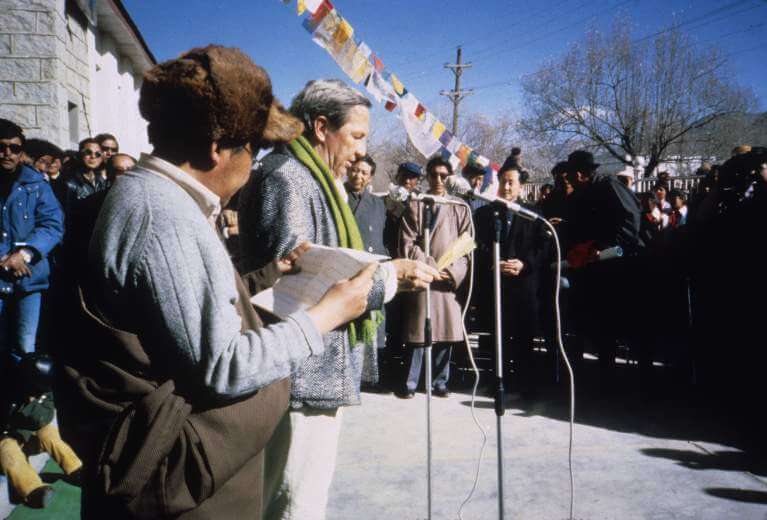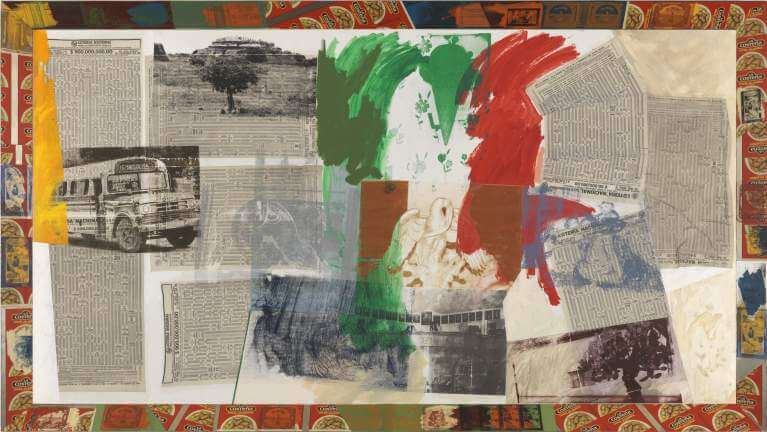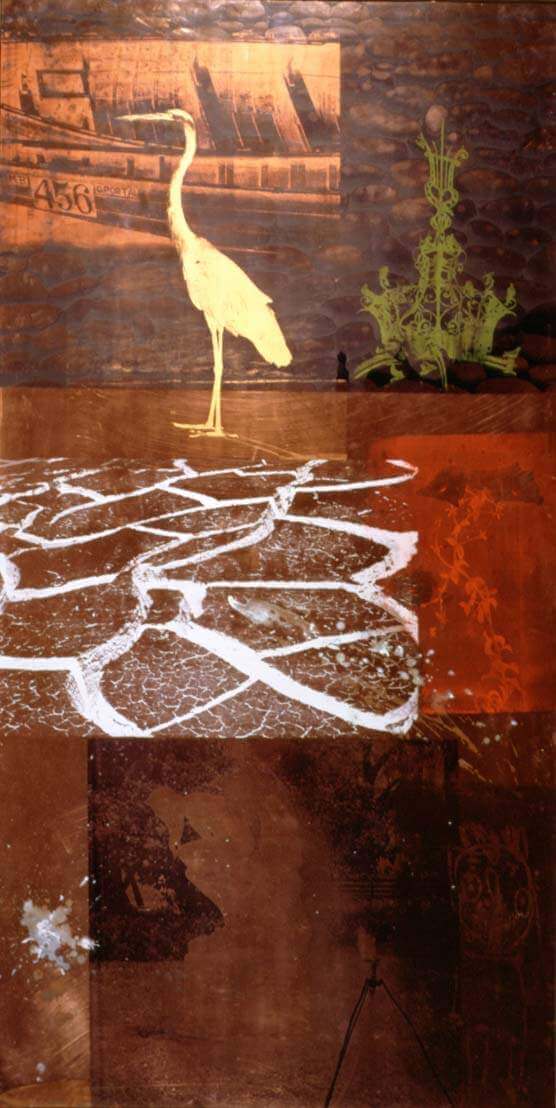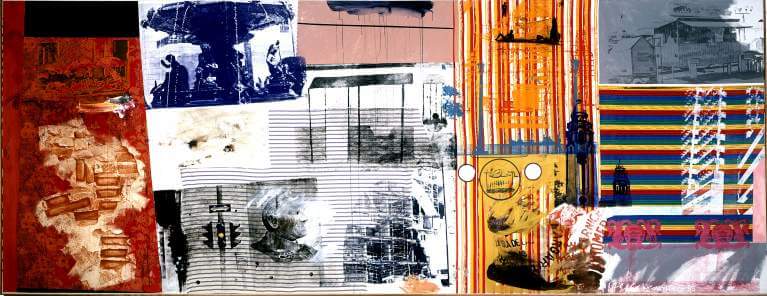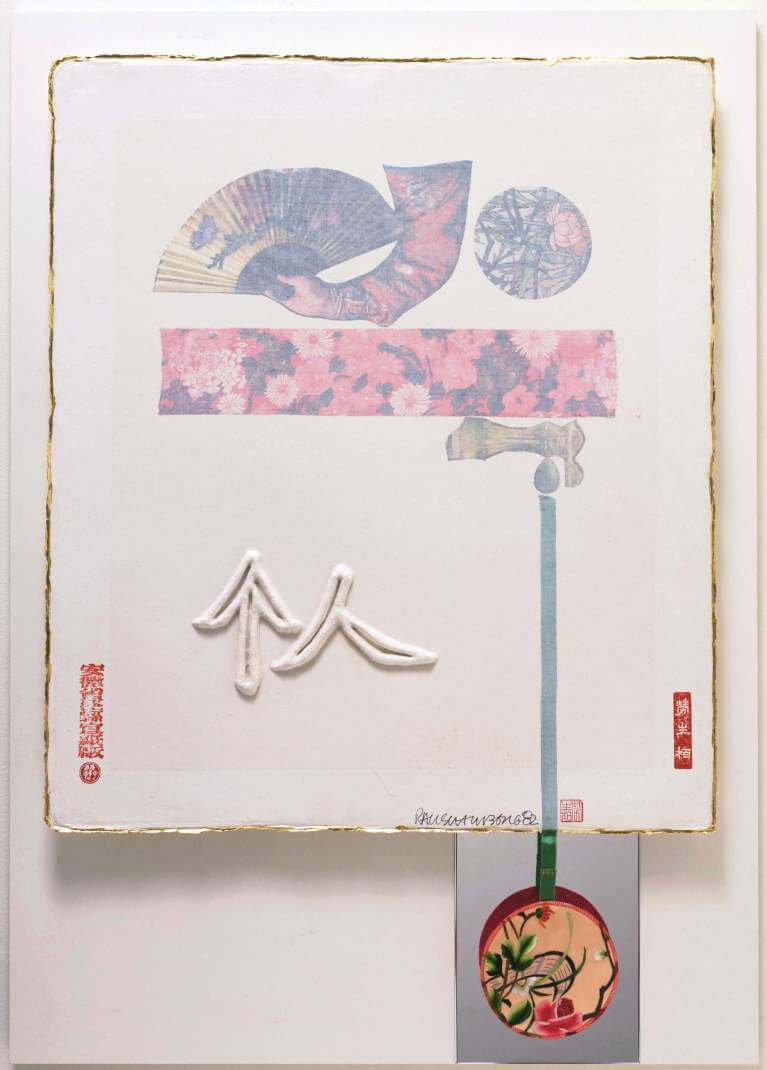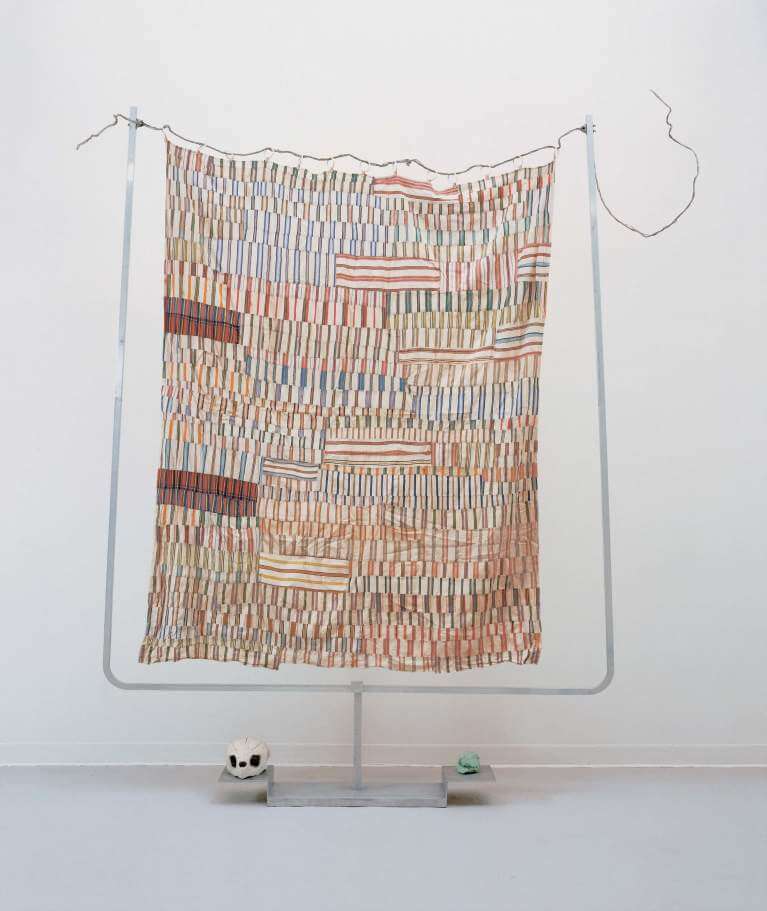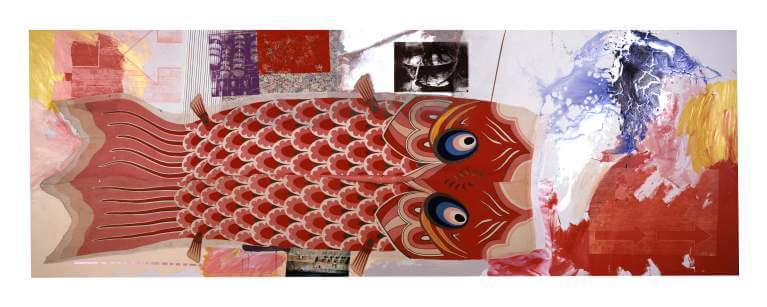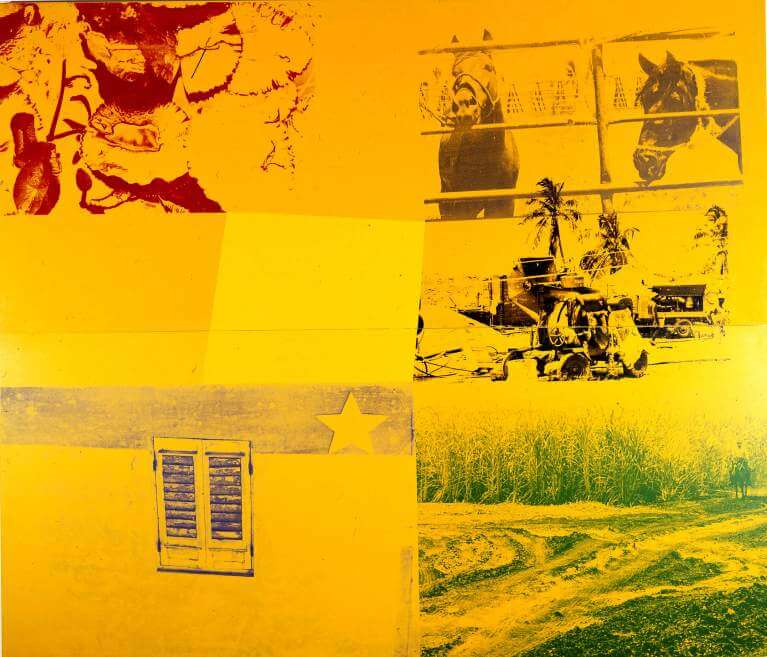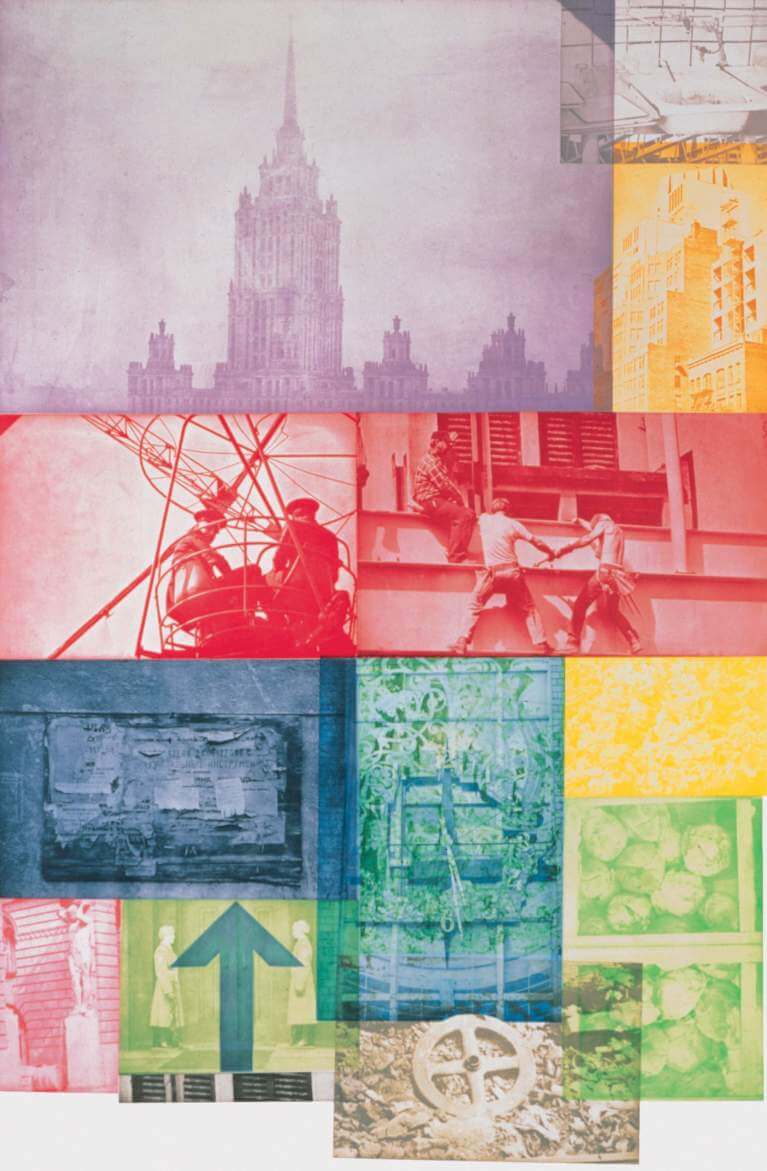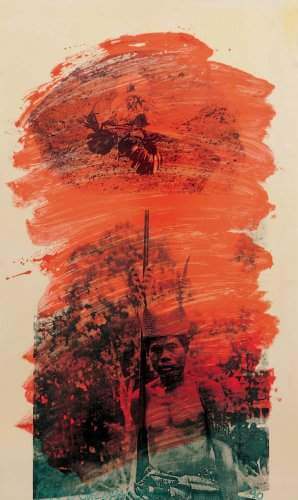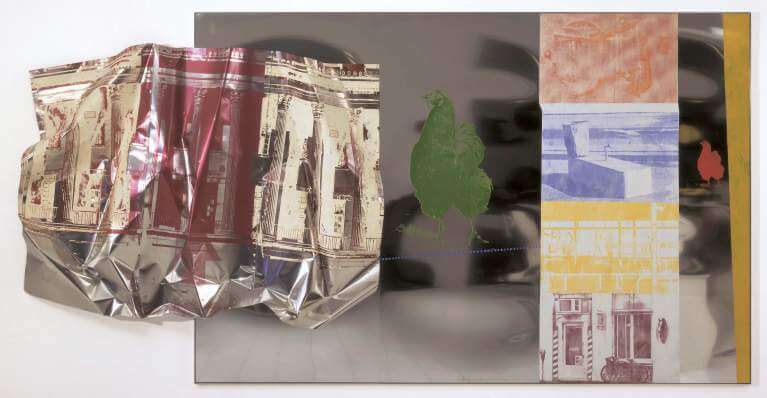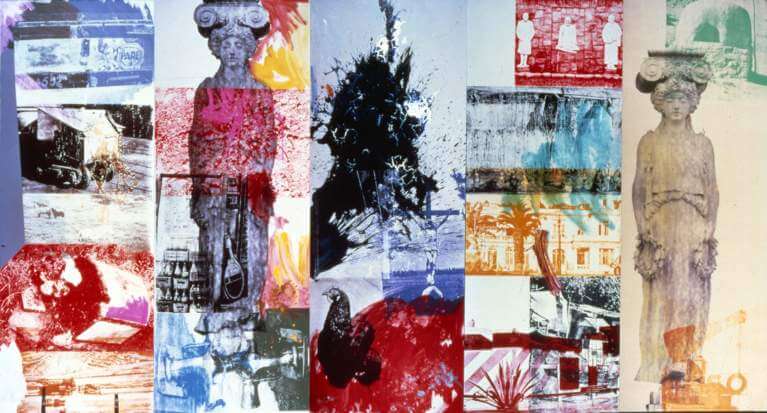
Caryatid Cavalcade I / ROCI CHILE, 1985
Rauschenberg Overseas Culture Interchange (ROCI)
Rauschenberg’s belief in the power of art as a catalyst for positive social change was at the heart of his participation in numerous international projects in the 1970s and early 1980s, and which culminated between 1984 and 1991 with his Rauschenberg Overseas Culture Interchange (ROCI). ROCI (pronounced “Rocky,” the name of the artist’s pet turtle) was a tangible expression of Rauschenberg’s long-term commitment to human rights and to the freedom of artistic expression. Funded almost entirely by the artist, Rauschenberg traveled to countries around the world often where artistic experimentation had been suppressed, with the purpose of sparking a dialogue and achieving a mutual understanding through the creative process. Between 1985 and 1990, the project was realized in ten countries in the following order: Mexico, Chile, Venezuela, China, Tibet, Japan, Cuba, the Union of Soviet Socialist Republics (USSR), Germany, and Malaysia with a final exhibition held in 1991 at the National Gallery of Art, Washington, D.C.
Rauschenberg and a Tibetan official at the opening ceremony for ROCI TIBET, Revolutionary Exhibition Hall, Lhasa, December 5, 1985. Photo: Thomas Buehler
During a visit to Tobago in 1984, Rauschenberg wrote a statement regarding the purpose of the soon-to-be-announced ROCI project. He saw it as a way of “taking, making, and exchanging art and facts around the world.” He continued:
"I feel strong in my beliefs, based on my varied and widely traveled collaborations, that a one-to-one contact through art contains potent peaceful powers and is the most non-elitist way to share exotic and common information, seducing us into creative mutual understandings for the benefit of all."
ROCI was announced at the United Nations in New York in December 1984. Rauschenberg created more than 125 paintings, sculptures, and editioned objects in connection with the project.
Mexican Canary / ROCI MEXICO, 1985
The first ROCI exhibition was held in Mexico City in 1985 at the Museo Rufino Tamayo Arte Contemporáneo Internacional. As with the subsequent ROCI exhibitions, the presentation in Mexico City included Rauschenberg artworks from earlier in his career, as well as works that were particularly inspired by the host country. ROCI MEXICO consisted of a series of paintings and collaged wall reliefs. Future ROCI exhibitions would always include new works inspired by the venue and those works that had been exhibited in previous ROCI exhibitions, thus providing a connection between the various exhibitions around the world.
Copperhead—Bite VI / ROCI CHILE, 1985
In 1984, Rauschenberg traveled to Chile, visiting Santiago, the countryside, and the desert region in preparation for the next ROCI project. During his research, Rauschenberg visited a copper mine and foundry outside of Antofagasta, which led him to use copper supports for his series of silkscreened photographs entitled Copperhead (1985/1989). The surfaces of these works are patinated with tarnishing agents to create somber hues. Rauschenberg’s choice of copper was a sign of solidarity with the Chilean people, many of whom worked in the mines and against Chile’s Dictator, President Augusto Pinochet, whose reign of terror had begun in 1973 and did not end until 1998. Due to Pinochet’s repressive regime, Rauschenberg met with students, artists, and political activists in Catholic churches—the only trusted institution in which the people felt safe to congregate. The ROCI CHILE exhibition opened at the Museo Nacional de Bellas Artes, Santiago, in July1985. Dissident poet José Donoso contributed a text to the exhibition catalogue, partially quelling criticism that the exhibition was presented in a national museum.
Primo Calle / ROCI VENEZUELA, 1985
In June 1985, Rauschenberg traveled to Caracas and Maracaibo, as well as to the Amazonian Territory in preparation for ROCI VENEZUELA. For the exhibition that opened the following September at the Museo de Arte Contemporáneo de Caracas, Rauschenberg created a series of paintings and collages on canvas and plywood; as with most of the ROCI venues, Rauschenberg donated one of the exhibited works as a gift to the host country. He received the Andres Bello medal for outstanding achievement in the fields of culture and education, presented on behalf of Venezuela by President Jaime Lusinchi.
Individual (From 7 Characters), 1982
More than 300,000 people attended the ROCI CHINA exhibition that opened at the National Art Gallery, Beijing, in November 1985. Included in the presentation were examples of Rauschenberg’s 7 Characters (1982), a series of unique collages representing seven Chinese characters. The works were made in collaboration with papermakers at the world’s oldest-known paper mill, Xuan Paper Mill in Jingxian, Anhui Province. Before spending two weeks at the mill, Rauschenberg traveled throughout the country visiting museums, cities, villages, archaeological sites, and meeting with art students in Beijing. Photographs from the trip are included in his photographic mural, Chinese Summerhall (1982–83), which was also part of the ROCI CHINA presentation. During the run of the exhibition, Trisha Brown Dance Company performed Glacial Decoy (1979), Set and Reset (1983), and other works at the Minzu Wenhua Gong Theater, Beijing. Rauschenberg received a Certificate of Merit from the Ministry of Culture, Beijing, for the exhibition’s contribution to cultural exchange. ROCI CHINA provided a rare view of Western contemporary art. In a country where traditional media and methods were the artistic norm, Rauschenberg’s unusual choice of materials and techniques was eye-opening.
Rainbow Harp / ROCI TIBET, 1985
Rauschenberg found it difficult to create works for Tibet because the Tibetans “have that total respect for all things. . . . There is no hierarchy in materials. . . . I thought they were so close to my own sensibility that I think that was the most difficult show I had to make.” The exhibition, held in December 1985 at the Tibet Revolutionary Hall in Lhasa, included sculptures constructed primarily with found objects from junkyards in Florida. Rather than donate a work of art to the people of Tibet, which had no cultural institutions to receive it, Rauschenberg donated video equipment.
Fish Park / ROCI JAPAN, 1984
Rauschenberg’s engagement with Japan and Japanese printmaking and design techniques began in 1964 when the artist was touring with the Merce Cunningham Dance Company. Later, in 1982, Rauschenberg worked at the Otsuka Ohmi Ceramics Company in Shigaraki where he created “ceramic paintings” by transferring silk-screened images to ceramic supports; motifs reminiscent of the Combines as well as imagery from ancient and contemporary Japan were found in the Japanese Clayworks (1982–83/1985) and combined with Western art icons in the Japanese Recreational Clayworks (1982–83/1985/1989). In 1984, using photographs he took in Japan that were then transferred onto canvas or fabric, Rauschenberg began to make artworks specifically for ROCI JAPAN. These works, as well as examples of the ceramic works made in Shigaraki, were exhibited in December 1986 at the Setagaya Museum of Art, Tokyo.
Yellow Ranch (Rancho Amarillo) / ROCI CUBA, 1988
For ROCI CUBA, Rauschenberg produced a series of paintings on aluminum and steel using vivid primary colors, evoking the pre-1959 American cars commonly seen in Havana. His works were exhibited in 1988 at the Museo Nacional de Bellas Artes, the Castillo de la Fuerza and Casa de las Américas, and at the Galleria Haydee Santamaría, Havana. Countering criticism that his paintings did not celebrate the complete history of Cuba, Rauschenberg, during an open forum for students and the public, maintained, “To break down barriers, I think you need to see as an alien does—to get lost in the city, or in the country, to see things in Cuba that maybe you are blind to.” Due to the U.S. embargo on Cuba, works for the exhibition were required to pass through Mexico before arriving in Cuba. On the evening prior to the exhibition opening in February 1988, Cuban Premier Fidel Castro honored Rauschenberg with an official dinner at the Palacio de la Revolución, Havana.
Soviet / American Array VII, 1988
In preparation for the ROCI USSR exhibition at the Tretyakov Gallery, Moscow, in February 1989, Rauschenberg traveled extensively in the Union of Soviet Socialist Republics (USSR). He visited Leningrad, Tbilisi, and Samarkand, as well as Moscow, where he met with the minister of culture and representatives from the Artists’ Union. ROCI USSR was the first solo exhibition of a Western post–World War II artist in the USSR, attracting more than 145,000 visitors. Among the works included in the exhibition were examples from his Soviet/American Array (1988–90), a series of photogravures that include a combination of Soviet and American imagery, as well as Samarkand Stitches (1988), a suite of wall hangings made from silkscreened sewn fabric. Poet Yevgeny Yevtushenko wrote in the exhibition catalogue, “For us, his exhibit is one of the symbols of a spiritual perestroika of our society.” Concurrent with the presentation at the Tretyakov, the Trisha Brown Dance Company also performed at the Cultural Palace.
As a tribute to Rauschenberg’s arrival in Moscow, a group of young non-union Soviet artists organized an exhibition of their own work, Rauschenberg to Us, We to Rauschenberg. It was the inaugural exhibition of Moscow’s first commercial gallery, which becomes known as the First Gallery. Works from the exhibition were selected by the Soviet Minister of Culture to represent the USSR at the 44th Venice Biennale in 1990.
Bach’s Rocks / ROCI BERLIN, 1990
In the spring of 1989, Rauschenberg canceled plans for a ROCI BERLIN project due to his frustration with East German officials who were resistant to a simultaneous East and West Berlin installation that all Germans could visit. With the opening of the Berlin Wall in November, plans for the exhibition were reinstated. Rauschenberg traveled to the city to gather materials for the project, using them to create a series of silkscreen paintings on plywood. ROCI BERLIN opened at the Neue Berliner Galerie of the Altes Museum in March 1990.
Hutan Belantara (Virgin Forest) / ROCI MALAYSIA, 1990
In the fall of 1989, Rauschenberg traveled to Malaysia to prepare for his ROCI project there. During his visit, he attended the inauguration ceremony for the new king and visited local tribes. In Sarawak, Borneo, he bought hundreds of “Save the Forest” T-shirts and bamboo bracelets, hoping to help people whose livelihoods as hunters were being destroyed along with the rain forests. The painting series for ROCI MALAYSIA (1990) reveal the artist’s concern for the conflict between urban and indigenous cultures within the country. The exhibition opened in May 1990 at Balai Seni Lukis Negara (National Art Gallery) in Kuala Lumpur.
Washington’s Golden Egg / ROCI USA (Wax Fire Works), 1990
In October 1990, Rauschenberg began to produce Wax Fire Works (1990–91) for ROCI USA. The series was created in association with Saff Tech Arts, Oxford, Maryland, a workshop run by Donald Saff, Rauschenberg’s collaborator since the early 1970s and the artistic director of the ROCI project. These large-scale works were made using a technique that Rauschenberg coined “fire wax,” in which wax containing pigment is painted or silkscreened onto polished aluminum supports and fixed using heat, as in traditional encaustic painting. The final Rauschenberg Overseas Culture Interchange (ROCI) exhibition, ROCI USA, opened at the National Gallery of Art, Washington, D.C., in May 1991. Rauschenberg’s artworks from each of the ROCI venues were exhibited along with a selection of his photographs taken during his travels. Travelogue videos, made by members of Rauschenberg’s team, ran continuously on monitors throughout the show.
Color video with sound, 61 min., 57 sec.
Rauschenberg Overseas Culture Interchange (ROCI) compilation of footage from Mexico, Chile, Venezuela, China, Cuba, and Tibet.
--
This text has been adapted from both the Overview and the Chronology that appear on this website

